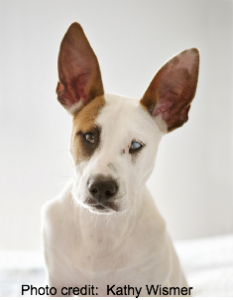
If you feel your dog may have cataracts, have your canine friend evaluated soon by a board certified veterinary ophthalmologist to obtain the facts about your dog's situation. Nuclear sclerosis gives off a bluish look to the inside of the eye, but unlike a cataract does not cause significant vision changes, require any medications or surgery. Uveitis and glaucoma can be very painful and eliminate the option of cataract surgery. The main concern with cataracts is the potential for the cataracts to cause other ocular problems such as inflammation (uveitis) and elevated pressure (glaucoma). are opaque (pearl like) which is different from a normal changing of the lens called nuclear sclerosis. Many smaller sized cataracts do not require surgery. Cataract surgery is highly successful, elective, and life changing. Currently, there is not a proven medical (non-surgical) treatment for cataracts. Eighty percent of diabetic dogs will develop cataracts, and many breeds carry the potential for cataract formation. The two most likely causes of canine cataracts are genetics and diabetes mellitus.

This journal provides immediate open access to its content on the principle that making research freely available to the public supports a greater global exchange of knowledge.Numerous clients inquire about cataracts, a common condition in dogs. Abstracted/Indexed inĬurrent Contents ®/Agriculture, Biology and Environmental SciencesįSTA (formerly: Food Science and Technology Abstracts)Īll contents of the journal is freely available for non-commercial purposes, users are allowed to copy and redistribute the material, transform, and build upon the material as long as they cite the source. Similarity CheckĪll the submitted manuscripts are checked by the CrossRef Similarity Check. Physical exercise, ocular variables, ocular blood flow References:Īsk for email notification. Our results suggest that exercise induces the modification of the ophthalmic blood flow in dogs, presumably related to the compensatory neuro-hormonal mechanisms. During the test, a linear correlation between the RI and the IOP was observed. A significant decrease in the IOP (11+/3.39 mmHg) was recorded after 60 min of the passive recovery phase at the end of the exercise, a slight decrease (12.29+/4.26 mm Hg) mm Hg was detected. A significant decrease in the RI was observed immediately after the exercise (0.697 +/–0.035) and during the passive recovery phase (0.682 +/–0.042). Spearman’s rank correlation for non-normal distribution was used to determine a relationship between the RI and the IOP. Wilcoxon’s test was applied for the post hoc comparison.

The data were analysed by a two-way repeated ANOVA measurement in order to compare the RI and the IOP. At the same times, the IOP was recorded by applanation tonometry. A colour Doppler examination was performed and the RI values were calculated for the medial long posterior ciliary artery at rest, immediately after the exercise, and after 60 minutes at the end of the exercise. Ten clinically healthy dogs were subjected to moderate physical exercise on a canine motorised treadmill at different speeds for 45 minutes.

The purpose of this study was to evaluate the influence of the exercise on the RI of the medial long posterior ciliary artery in dogs, and correlate the data obtained with the IOP values.

Some ocular variables such as the intraocular pressure (IOP), the choroidal thickness, the axial length and the ocular blood flow may be influenced by physical exercise. The resistive index (RI) is an indirect measurement of arterial resistance by means of a ratio between the peak systolic and end diastolic velocities recorded with a spectral Doppler device, especially used to evaluate the vascular damage in ocular diseases such as glaucoma.


 0 kommentar(er)
0 kommentar(er)
